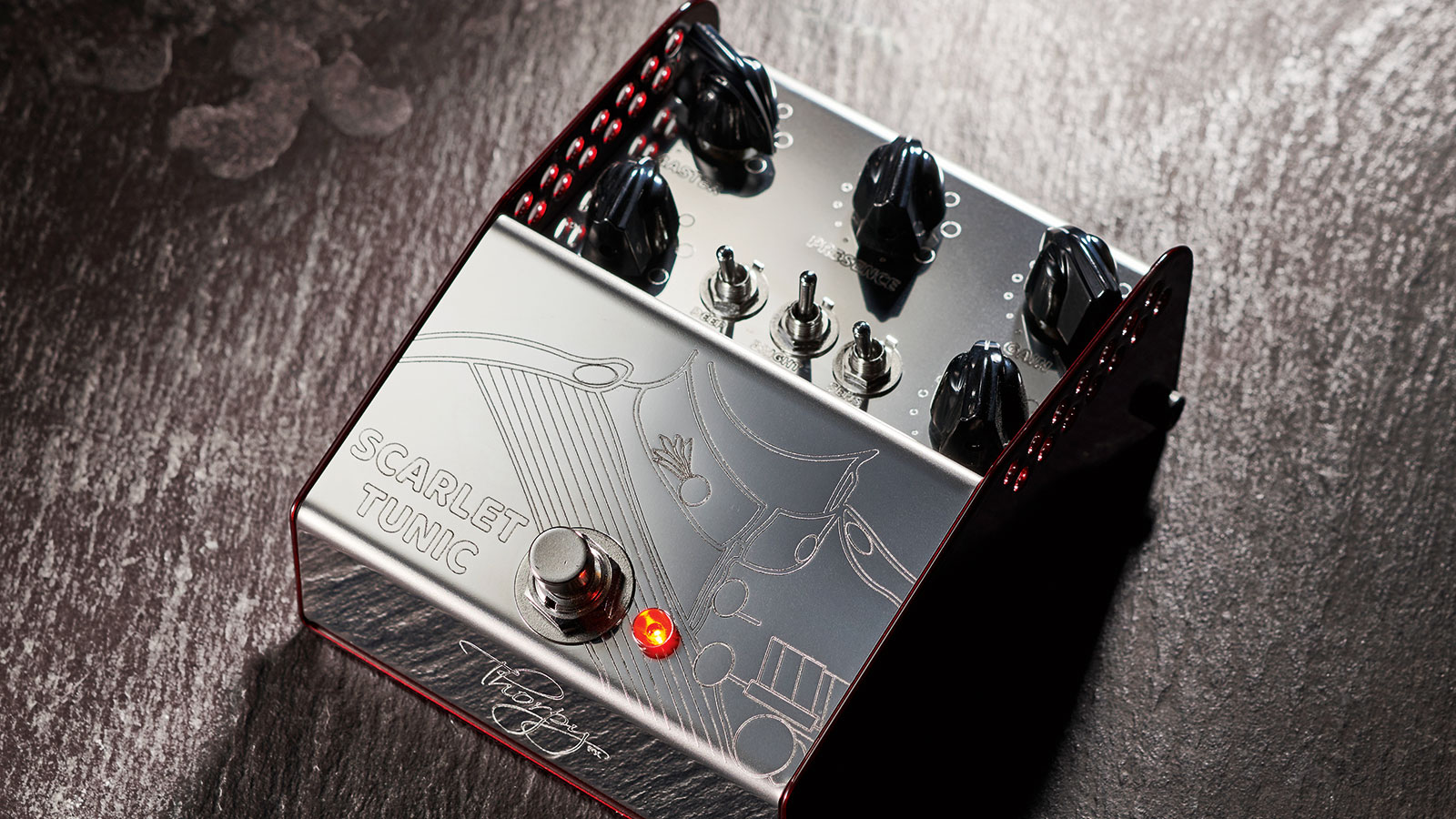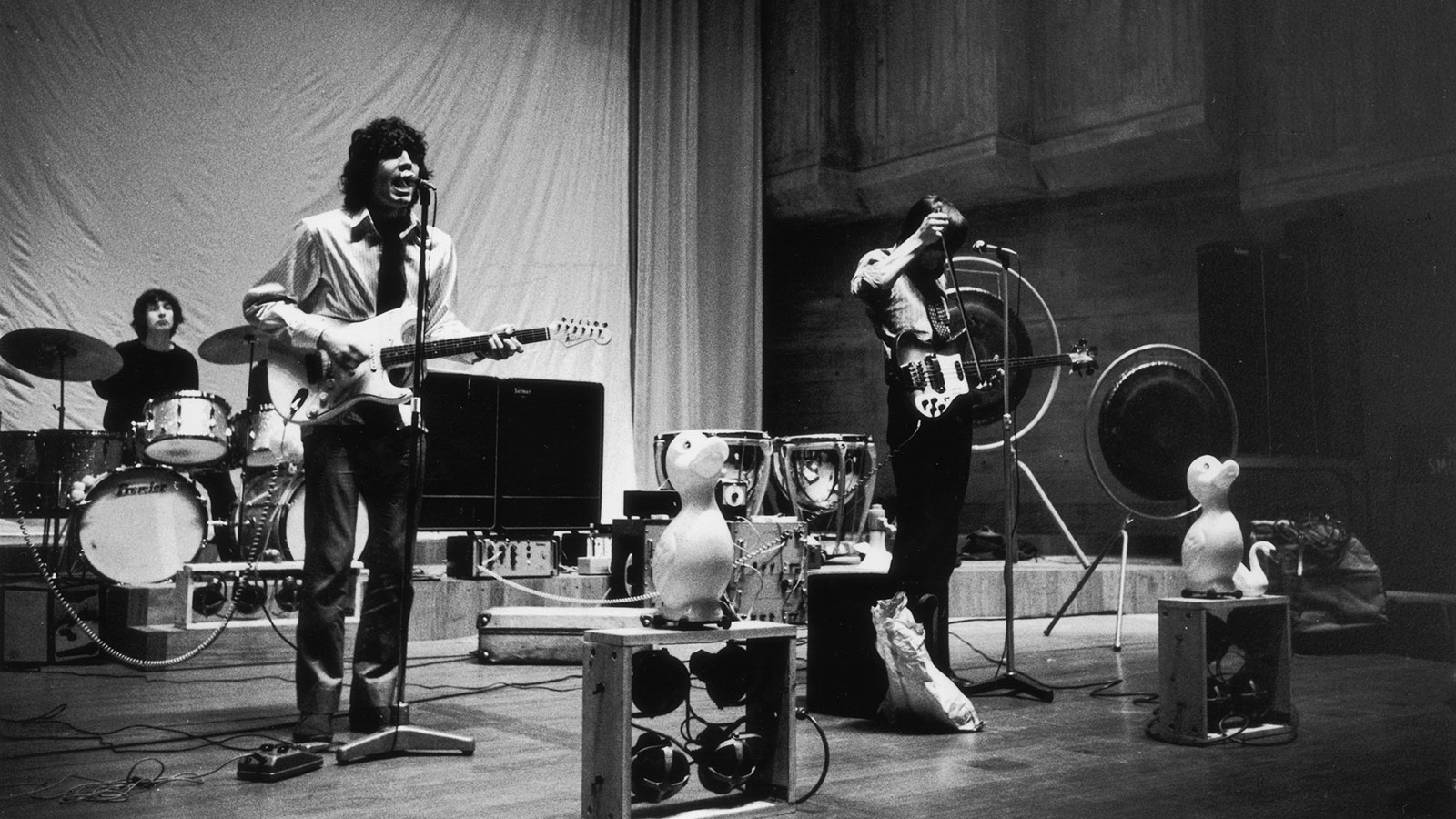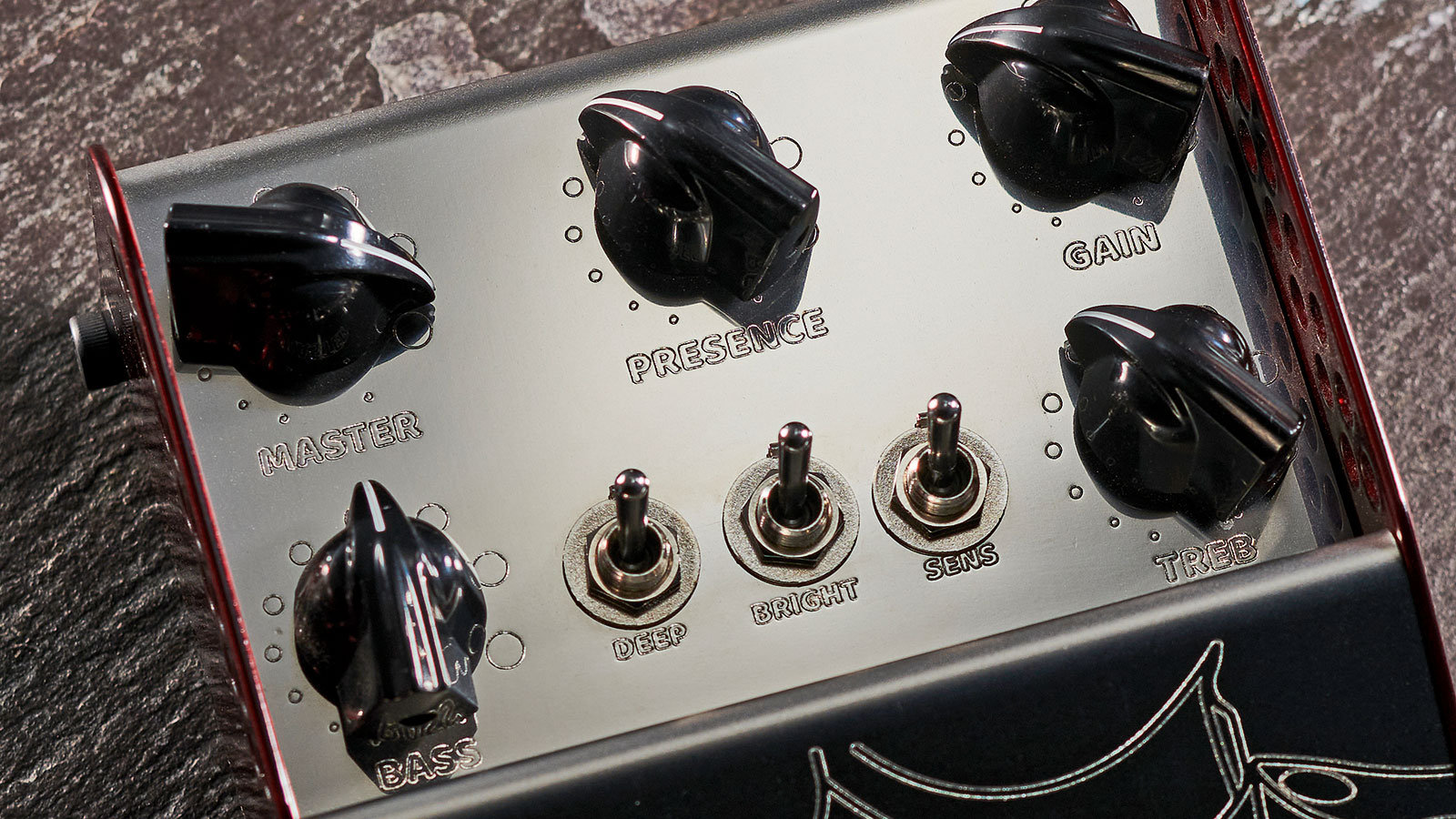How ThorpyFX harnessed Syd Barrett’s signature Selmer tones for the Scarlet Tunic
British pedal maker ThorpyFX has teamed up with Lee Harris of Saucerful of Secrets to capture the sound of Syd’s Selmer, but as we find out, there is a lot more to the Scarlet Tunic besides nailing those early Pink Floyd guitar tones

Few sounds in rock are as viscerally memorable as the growling twang of Syd Barrett’s guitar in the opening notes of Pink Floyd’s Interstellar Overdrive from the band’s 1967 debut album, The Piper At The Gates Of Dawn.
Unlike the stratospheric, soaring tones that characterized later-era Floyd tracks with David Gilmour on guitar, Syd Barrett’s electric guitar sound is jagged, janky and wiry, somewhere between Vox and Marshall in voice.
The reason it’s a bit hard for the ear to pin down is that Syd used Selmer guitar amps, which are collectible vintage items these days but largely forgotten by mainstream guitarists.
The Treble And Bass model that Syd played on Floyd’s debut album is perhaps the best-known of Selmer’s 60s creations, but, for many years, the only way to capture the distinctive sound of that amp was to buy an old one and get it running reliably.
For Lee Harris, guitarist with Floyd spin-off project Nick Mason’s Saucerful Of Secrets, that wasn’t really a viable option. With Nick himself on drums, the standard of sonic accuracy in the band, which performs songs from Floyd’s early albums, had to be high. So Lee decided to approach British effects maker ThorpyFX to see if the elusive tone of the Treble And Bass could be conjured up in an effects pedal.
“I was using a Plexi-type pedal,” Lee recalls, “but what was annoying for me was it just sounded like a generic sound of that period. I felt like I really needed to get the sound that Syd had on the album. I needed to honor that more because his two solo albums haven’t got that distorted Interstellar sound on them and there isn’t anything else of his out there [that sounds similar].

“It’s just that album with that sound on it. And I really wanted to honor it correctly, you know, so that’s when I went to Thorpy and said, ‘Is there any way to put a Selmer Treble And Bass into a pedal?’ Dan Coggins [the effects designer behind Lovetone and present-day ThorpyFX collaborator] has a late-1966 Treble And Bass 50-watt MKII. We don’t know exactly what [version of the Treble And Bass] Syd had. We presume it was the same amp, though. He also had a Selmer Stereomaster. But it’s the same tone stack, you know?”
Get The Pick Newsletter
All the latest guitar news, interviews, lessons, reviews, deals and more, direct to your inbox!
The danger with pedals that emulate amps is, of course, that you conjure up the general flavour of the original but fail to capture the sonic soul of the valve-driven amp the effect is based on. But Lee says ThorpyFX was able to get an uncommonly good match to the sound of the original.
It doesn’t sound like other pedals that are a clone of an amp. This really does sound like the Selmer. It’s crazy
Lee Harris
“We actually A/B’d the pedal and the original Selmer head, and the pedal won out because it was less noisy,” Lee laughs.
“Which was hilarious. I mean, in some cases, you want to hear all that buzz and fuss, but I don’t particularly need it on stage. So that was amazing. The other thing I found with the Scarlet Tunic is that it really does sound like there’s a tube inside it and it doesn’t sound like other pedals that are a clone of an amp. This really does sound like the Selmer. It’s crazy.”
Adrian Thorpe, founder of ThorpyFX, chimes in at this point to explain that while the Scarlet Tunic achieves its stated goal of replicating the sound of Syd’s Treble And Bass amp, he was also keen to broaden its tonal range so the pedal is useful to a much wider range of players than just early Floyd fans. The end result was an overdrive that Adrian hopes will appeal to everyone from classic rockers to alt-rock guitarists.
“The Selmer Treble And Bass is quite a weird and wonderful amp for most people,” Adrian reflects. “Most people won’t have seen one. And while they might have heard one, they possibly won’t realize they’ve heard it.
“We’ve made the pedal so it spans pretty much what the amp can span [tonally], which is between a Hi-Watt and a Marshall. You can get Paul Kossoff All Right Now tones from it, for example. Obviously, you can get early Floyd, too, but it does much more than just those two sounds.”
Beyond the Piper
Adrian adds that careful design has yielded a much more amp-like circuit than is the norm for solid-state pedals.
“It’s got an internal transformer; it clips and sags in the right way. You can have it so it feels ‘fast’ [rapidly responsive to touch], like a Two-Rock, or you can calm it down and have a little bit more gain and a little bit more sag. It’s a very cool little concept,” he says.
Lee Harris agrees, saying that although he originally only wanted the pedal to emulate Syd Barrett’s The Piper At The Gates Of Dawn guitar sounds, it ended up being far more versatile than he anticipated and he now uses it right across the Saucerful setlist and other projects, too.
It’s not a one-trick pony... there’s a lot more going on than just the Syd stuff
Lee Harris
“What Thorpy’s done is put a bit more gain on the Scarlet Tunic [than the original amp had]. So it’s not a one-trick pony. It’s not like you plug it in and you immediately sound like Syd Barrett – you’ve got to find the tone.
“For example, I heard that Paul Kossoff used a Selmer to do the All Right Now solo, and you can get those kinds of sounds from the pedal, too – so there’s a lot more going on with it than just the Syd stuff. Also, I’m not a massive lover of traditional fuzz pedals because impedance issues always rear their head.

“But the Scarlet Tunic kind of gives me that other 60s fuzz sound that I really like – I suppose it’s more reminiscent of Vox AC30s and it hasn’t got the thinness of a [WEM/Rush] Pepbox... so I’m actually now using the Scarlet Tunic for more stuff than just the Syd material. And it’s not another bloody Tube Screamer! I think that’s a really cool thing, too. So I think it’s important that people realize it’s not just a way to get the Syd Barrett sound: there’s so much more to it.”
Returning to Adrian, we ask how he avoids the signature sound of the pedal being overpowered by the voice of the amp that it’s being plugged into.
“It’s difficult to have a pedal that will work with every single amp,” he admits. “Part of it is about trying to give the pedal enough of its own character to punch through. If you have too much gain from the front-end of the amp, what are you hearing? Are you hearing the pedal or the amp? There’s always a balance there. But we’ve got the Scarlet Tunic to the point where we’re happy and it gets that sound.
If you’ve got a clean channel on an amp that you can make fairly flat, EQ-wise, it will work very well
Adrian Thorpe
“Broadly speaking, we’ve designed it so that if you’ve got a clean channel on an amp that you can make fairly flat, EQ-wise, it will work very well,” he continues, “and we make sure that the pedal has enough of the key frequencies [of the original Selmer and similar Hi-Watt and Marshall amps] that you can overcome some of the tonal character of the amp you’re using. And that’s good because it means the pedal’s sound becomes dominant when you want it to be.
“Now, what amps might it struggle with? Probably Vox AC30s – why? Because they’re quite close in sonics [to the Selmer] to begin with. Generally, if you have an amp-like pedal that has the same kind of sound as the amp it’s going into – say, running a Marshall-style pedal into a real Marshall – it doesn’t sound that good.
“It’s like taking a shoe and putting it in another shoe [laughs]. But most of the time it will all work really well – and we have enough amps here to test our pedals through to know that they’re going to work [with a wide range of setups].”

In case you’re wondering about the pedal’s name, Adrian says that it’s a nod to the lyrics of the track The Gnome from The Piper At The Gates Of Dawn, which describe the clobber worn by the track’s eponymous hero.
The pedal’s styling also nods to a different inspiration, however. Adrian served in the British Army for many years before going into effects making, and the tunic depicted on the front of the pedal is a stylized version of the dress uniform of the Grenadier Guards, which Adrian chose as a personal tribute to a member of that regiment who had been a mentor to him and was sadly killed in action.
A Saucerful Of Sound
The Scarlet Tunic overdrive now forms the tonal centerpiece of Lee Harris’s live rig in the Saucerful Of Secrets band, but he’s got plenty of other sounds up his sleeve, he explains, though in recent months he’s whittled down his pedalboard a bit for ease of use.
One of my pet hates is kneeling down and changing settings [on individual drive pedals] while there’s an audience in front of me
Lee Harris
“What I’m using now is far simpler than what I had before,” Lee explains. “Part of the problem is that I live in France, but my [live rig] was being put together in England, so rather than buy pedals over here and then send them back, I was just buying stuff online and getting it sent to England.
“So I was reading up about stuff online and thinking, ‘Well, this would do that, this would do the other...’ you know? And I ended up with 14 pedals on the ’board – largely because I had about eight drives. That’s because one of my pet hates is kneeling down and changing settings [on individual drive pedals] while there’s an audience in front of me.
“But this time around what I’ve gone for is having a pedal with a hair of gain on it, a boost basically, plus some sort of medium-gain pedal as well. And then I’ve got a Big Muff and I’ve got the [Scarlet Tunic] Selmer and that’s it, really. That’s all I need, drive-wise. I’ve also got a compressor because if you’re wanting to play things like Echoes, you kind of need to have a compressor going, just to get that sound in certain parts.
“I’ve also got a phaser and a delay – a Free The Tone Future Factory – because it’s two delays in one box, so that means I don’t have to have two separate delay pedals on the ’board. I’ve also got a Free The Tone EQ that I use very sparingly in a couple of places. As well as that, I’ve got a volume pedal and a wah-wah that Analog Mike [Piera] has customized so it will produce the seagull sounds for Echoes,” he explains.

Lee’s mention of Echoes is timely because the band’s current tour focuses on that immersive yet under-rated track from 1971’s Meddle album – which sees Gilmour’s classic sound slowly taking shape.
“Well, it’s called the Echoes tour and I always thought Echoes was kind of like a bit of an elephant in the room if you didn’t do it, because it is certainly the one that sounds most like what the band went on to do.
“That said, Gary Kemp [frontman and co-guitarist for Saucerful Of Secrets] and I are in the very lucky position that we’re playing songs from the era when David hadn’t quite got his guitar style [nailed down] yet. So we can actually muck around with it because they’re not sacrosanct, these pieces of lead that he’s playing on Let There Be More Light, for instance – and even, to a point, Atom Heart Mother...
“If you listen to The Early Years boxset or just any bootlegs from that time, David never played those solos the same from night to night, ever. It was always slightly different. He wasn’t yet into that realm of tracks like Money, which everyone wants to hear the same way every time it’s performed. So we’re recreating, we’re not copying, I suppose.
“What I’m trying to spit out is that in this era [of early Floyd] there are so many different styles of music: obviously you’ve got psychedelic stuff, you’ve got 60s pop, you’ve then got prog, you’ve got heavy rock with something like The Nile Song... You’ve got almost hymn-like classical things like Saucerful Of Secrets or Celestial Voices at the end of A Saucerful Of Secrets. There are so many different styles.”
- For more info on upcoming tours see Saucerful of Secrets; for more on the Scarlic Tunic, visit ThorpyFX.
Jamie Dickson is Editor-in-Chief of Guitarist magazine, Britain's best-selling and longest-running monthly for guitar players. He started his career at the Daily Telegraph in London, where his first assignment was interviewing blue-eyed soul legend Robert Palmer, going on to become a full-time author on music, writing for benchmark references such as 1001 Albums You Must Hear Before You Die and Dorling Kindersley's How To Play Guitar Step By Step. He joined Guitarist in 2011 and since then it has been his privilege to interview everyone from B.B. King to St. Vincent for Guitarist's readers, while sharing insights into scores of historic guitars, from Rory Gallagher's '61 Strat to the first Martin D-28 ever made.
“Its superpower is punching your guitar tone with presence, thickened gain and sustain”: SoloDallas SVDS Boost review
“Jimi was staying at a hotel in Times Square. He had his hair set in pink curlers and we would just talk band drama”: Electro-Harmonix founder Mike Matthews on befriending Hendrix, booking Chuck Berry and the birth of pedal culture








![[from left] George Harrison with his Gretsch Country Gentleman, Norman Harris of Norman's Rare Guitars holds a gold-top Les Paul, John Fogerty with his legendary 1969 Rickenbacker](https://cdn.mos.cms.futurecdn.net/TuH3nuhn9etqjdn5sy4ntW.jpg)


